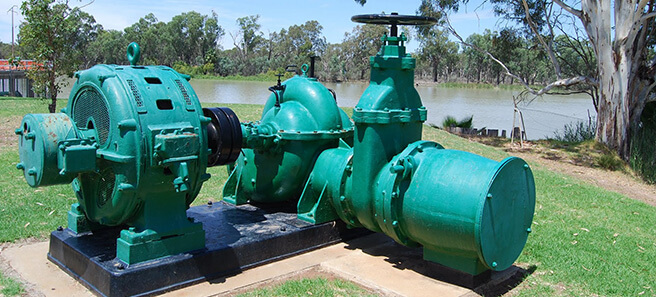The pump is the heart of the irrigation system. Making sure it is the right pump for the job and that it is working properly can save energy costs. But across the irrigation industry typically half of all pumps are found to be not operating efficiently. As a result energy costs are higher than they need to be.
The pump performance is determined by both the pump and motor performance. As shown below, pump performance is more important than the motor in determining net efficiency . Typical improvements in the efficiency of the pump reduce the daily energy use by 19% and cost by $7.91/ML; typical improvements in the efficiency of the motor reduce the daily energy use by 3% and costs by only $0.80/ML.
| Improving only pump efficiency | Improving only motor efficiency | |||
| Pump 1 | Pump 2 | Pump 3 | Pump 4 | |
| Pump efficiency | 65% | 80% | 80% | 80% |
| Motor efficiency | 91% | 91% | 90% | 93% |
| KW at pump | 36.2 | 29.4 | 29.4 | 29.4 |
| KW at meter | 39.8 | 32.3 | 32.7 | 31.7 |
| KW/h | 39.8 | 32.4 | 32.7 | 31.6 |
| Runtime (h/day) | 16 | 16 | 16 | 16 |
| Total KWh/day | 637 | 518 | 523 | 506 |
| Cost per day | $97.20 | $78.98 | $79.85 | $77.28 |
| Cost per ML | $42.19 | $34.28 | $34.66 | $33.54 |
Working out the operating cost and efficiency of existing pumps is reasonably straightforward – See “How efficient is your pump” (NSW DPI), “Selecting the right pump for an irrigation system” (Ag WA) or “Pumping efficiency” (Growcom) for more information.
The pump
Pump efficiency will be determined by how well the pump duty (flow rate and operating pressure) is matched to the requirements of the irrigation system. If this is wrong then costs will mount quickly.
The original design should include information on the system flow-rate and pressure and how efficiently the pump operates under these conditions, as indicated by the pump curve. Once a pump is installed the operating conditions can be measured.
It is good practice to measure pump efficiency in the commissioning phase of new systems to ensure the system, including the pump, is working as specified. This can pick up any problems and ensure energy use and running costs are minimised. Problems can include suction pipe diameter too small, lift too great and air entering the system (cavitation). These problems can drastically impact on a pump’s performance.
Over time a pump’s efficiency will decrease. By periodically measuring the pump’s efficiency and comparing this to the manufacture’s pump curve, the grower can decide when repair or replacement is cost-effective. This decision will involve a trade-off between increased energy use, and hence running costs, and the capital cost of the repair or replacement.
Appropriate maintenance is also required to maintain the efficiency of the pump. Problems with pumps can occur in the suction line, such as a blocked inlet, or a pipe damaged or crushed, or a build-up of deposits. On the pump, worn impellers and bearings, and seal and gland losses can all reduce the pump’s efficiency. Having a maintenance schedule and monitoring the performance of the pump will ensure these losses in performance remain at a tolerable level.
In summary, pump efficiency can be maximised by matching the pump to the irrigation system, good design of the pump station and regular maintenance. As a general rule, pump efficiency should be greater than 70% at duty; below this is poor. If you can get better than 80% this is excellent, with a maximum of 88% achievable in the field for an end-suction pump.
The pump motor
Electric motors increase in efficiency as they near full load. An electric motor operating at only 50% of full load will not be as efficient as one operating at close to 100% of full load. Aiming to have a motor that runs as close as practicable to full load can increase motor efficiencies by 2 to 5%.
As of Oct 2001 all three-phase electric motors from 0.73 to 185 kW, either manufactured or imported into Australia, must comply with minimum energy performance requirements as set out in AS/NZS 1359.5‐2000. This regulation was made even more stringent in April 2006, when the previous high-efficiency level became the new minimum standard. As a result all post-2006 three-phase electric motors are typically 2 – 3% more efficient than those manufactured before 2001.
Most irrigation pumps run at full speed no matter the load on the system. This can be very inefficient, particularly when a wide range of flow rates and pressures are needed, e.g. where flow rate varies due to different irrigation types or varying block size, or pressure varies considerably. A more energy-efficient system uses a variable speed drive to slow the motor speed to match the varying end-use requirements. If the irrigation-system flow rate or pressure does vary then variable speed drivers can reduce energy use.

